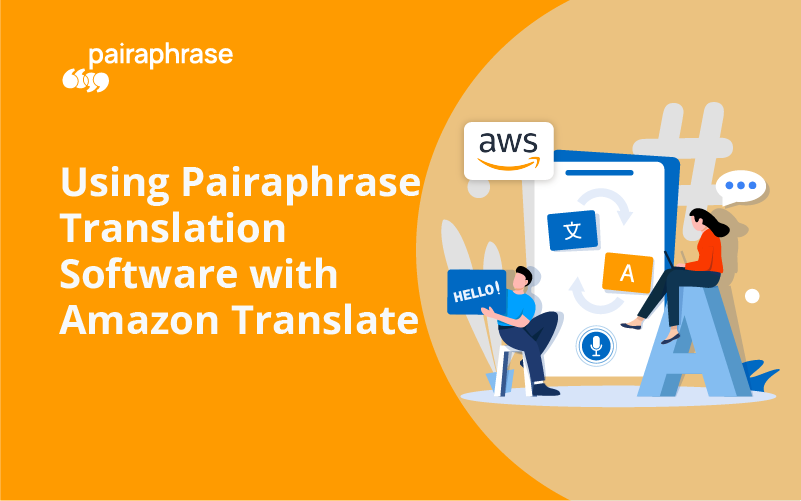Curious about Amazon Translate (PairaphraseGPT)? Pairaphrase is easy-to-use translation software with Amazon Translate (PairaphraseGPT) as a translation engine option. In this post, you’ll learn about using Amazon Web Services’ translation engine to create custom translations using Pairaphrase, the web-based translation management system for enterprises.
First, we’ll provide an overview of the PairaphraseGPT translation engine and what you can expect when you use Amazon Translate in Pairaphrase to translate documents and other files. Then, we’ll cover the benefits of Amazon Translate when used in Pairaphrase to produce high-quality translations.
Finally, you’ll get a better understanding about whether Amazon’s machine translation engine is a good fit for your organization and how to enable Amazon Translate in Pairaphrase.
Amazon Translate: PairaphraseGPT Translation Engine Overview
How is Amazon Translate Different from Other Translation Tools?
Amazon Translate uses neural machine translation, a more advanced alternative to the traditional statistical and rule-based translation algorithms that many translator tools use. Amazon uses its own artificial neural networks and deep learning system.
Google and Microsoft also use neural machine translation technology. The difference is that PairaphraseGPT allows users to create custom translations on-the-fly (on-demand) with just a glossary. You don't need millions of words of previously translated content to train the machine translation engine.
How Does PairaphraseGPT Translate Produce Custom Translations?
Whereas other translation engines require millions of words of previously translated content to train their machine translation engines before you translate your content, Pairaphrase and Amazon produce custom translations with them “on-the-fly.”
Is Amazon’s Translation Quality Better than Google and Microsoft?
Creating custom translations with Amazon, using glossaries and translation memories, will get you as close to human translation quality as possible.
While it delivers impressive high-quality translations, you get back what you put into it. This means you will need to dedicate a little more time upfront by creating machine translation optimized glossaries.
Pairaphrase & Amazon Translate
How Does PairaphraseGPT Translate Compare to Other Translation Engines in Pairaphrase?
Pairaphrase uses translation memory, dynamic machine learning, fuzzy matching and 100% matching functionality for all the engines it offers (Google, Microsoft, PairaphraseGPT, etc.). When using Pairaphrase, the interface is the same regardless of your translation engine choice.
However, translations produced with the Amazon translation engine take longer to process. This is because custom translations are produced on demand each time you click “Translate File.” For instance, it could take 20-30 minutes (compared to a few seconds or minutes).
It will take a little more work upfront and the processing is slower, but over time it yields more savings in terms of translation-related costs, hours worked and effort. You’ll spend far less time post-editing the machine translation output. That is, if you’re the right type of user for the PairaphraseGPT engine (refer to the next section).
When it comes to using the Translation Wizard in Pairaphrase to gist text (copy-and-pasted email text, messages, etc), PairaphraseGPT translate only uses translation memories (not glossaries). Pairaphrase’s File Translator uses translation memories and glossaries.
Is the PairaphraseGPT Translation Engine Right for My Organization?
Not everyone will benefit from translating with Amazon Translate’s engine. We recommend you only use the PairaphraseGPT engine if you meet the following criteria:
- Your organization has ongoing translation needs for its own content. That is content that you produce and control.
- You have or will create a machine translation optimized glossary for your content that has been uploaded and activated in Pairaphrase.
- You either have a translation memory and/or edit your file translations using Pairaphrase.
- Users can create a translation memory from their own previously translated files. They can create a TMX from their translated Word, PDF and Excel files.
We do not recommend using the PairaphraseGPT engine if…
- you have no control over how the content is produced that you need to translate (e.g. third-party documents you receive from another organization).
How to Use the PairaphraseGPT Translation Engine in Pairaphrase
How to Select the PairaphraseGPT Engine in Your Account:
- Log in to Pairaphrase
- Go to your user profile
- Select “Translation Engine” from the left-hand menu
- Choose PairaphraseGPT
- Click “Save”
How to Enable Amazon for Your Translation Memories & Glossaries:
- Select “Translation Memories” from the left-hand menu
- Identify the Translation Memories you want to use with Amazon (you can use both translation memory files and glossary files)
Note: For glossaries, Pairaphrase conveniently supports CSV files.* Glossary files will sync much faster than Translation Memory Files (also known as TMX files). This is because there tends to be a greater number of words in TMX files.
- Click the gear icon
- Select “Enable Amazon” (this tells Amazon to use these files during the actual translation process)
- First you’ll see a red dot, which means the engine is still syncing to your Translation Memory.
- When the dot turns green, you’re ready to start translating with PairaphraseGPT!
*With Pairaphrase, you no longer need to upload glossaries in TBX file format.
Get Started



.png)

.png)



